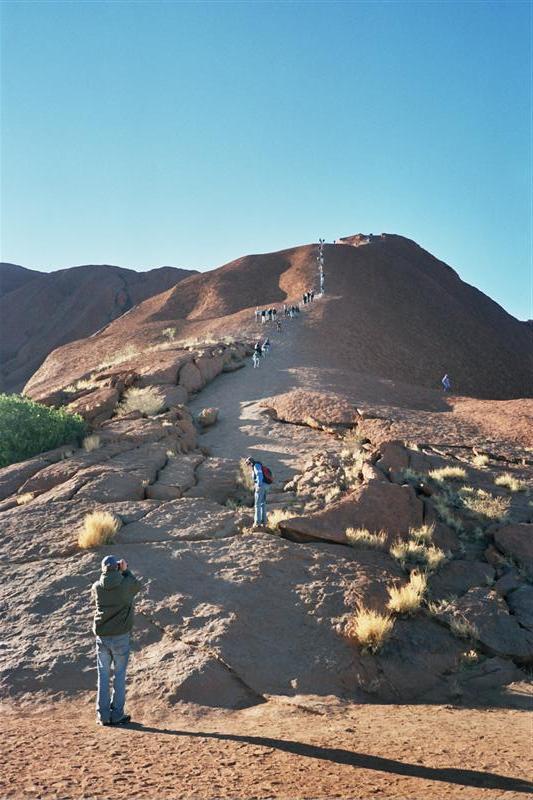Travel to Australia
Day 17 Ayers Rock (120 Km.)
(in 19 Km.) Uluru: We get up soon to do the goal that most of the tourists that go to Uluru have: Climb to the top of the rock. It takes approximately one hour to reach the summit with a total distance of 1,600 meters in length and 348 meters of unevenness. The ascension is divided into two parts. The first one, with a slope close to 60%, is carried out next to a chain that is used as a handrail that allows you to hold on to avoid slipping or falling backwards. The second part is softer but usually very windy and consists of following the path marked by a few painted lines to the summit.

Climb to Uluru
From the top you can see a 360 degree view of the desert, the nearby area of Kata Tjuta and the somewhat further Mount Conner. The aborigines who manage the park, the Anangu people, ask that no one climb to the top for spiritual reasons and because the accidents that occur throughout the year are a bad omen according to their beliefs. To climb it is recommended to bring plenty of water and a good cap to protect yourself from the Sun. In summer, if temperatures exceed 36 degrees, the climb is prohibited to avoid fainting from heat or dehydration. On rainy days the climb is not allowed because the rock becomes very slippery.

Top of Uluru and The Olgas in the background
The Uluru-Kata Tjuta National Park includes within its territory the Uluru rock, which is how Ayers Rock is named by Aboriginal people, and Kata Tjuta (or Olgas). The park is one of the most visited places in Australia. A few hundred meters from the base of the rock is the Uluru-Kata Tjuta Cultural Center, which contains a collection of aboriginal art and videos and explanations about its culture. There are also stores where you can buy local crafts (some digeridoo, boomerang, paintings, etc.).

Uluru Descent
At the base of the rock there are also some paths, among which the Mala Walk and the Uluru Circuit Walk stand out. The Uluru Circuit Walk is the excursion that surrounds the monolith of Uluru, with an approximate distance of about nine kilometers that lasts approximately three hours. It allows you to see closely the Anangu places of Uluru in which we can observe aboriginal paintings on the rock walls, although in some of them you cannot enter (or photograph) because they are sacred places. The Mala Walk is a walk of about two kilometers that passes through a cave with paintings and the Kantju Gorge. Another excursion is the Mutitjulu Walk, with an approximate length of one kilometer, which leads from the parking lot to the pond that according to the aborigines is home to Wanampi, an ancient water snake.

Uluru
(in 50 Km.) The Olgas: Kata Tjuta (meaning "many heads") is located about 45 kilometers west of the park entrance. It is a group of round hills (heads) divided by narrow and reddish valleys. You can only access a couple of trails, since the rest of the area is a sacred place. They say that all these hills are the result of the erosion of a monolith ten times larger than Uluru. Mount Olga, for instance, is 200 meters taller than Uluru.

The Olgas
The first of the two walks allowed is the Olga Gorge Walk, a two-kilometer walk in total between the round trip. The narrow path leads between two walls three hundred meters high to a chasm flanking Mount Olga, which with 546 meters is the highest point of the massif. The star of the area is the Valley of the Winds Walk, which is seven kilometers long and about two hours long. It is necessary to carry plenty of water and something to protect from the sun. The danger of dehydration is such that along the way there are signs that indicate how far away is the nearest "emergency" water source. The viewpoints on the different hills and the contrast of the green of the vegetation, the intense red of the hills and the blue of the sky stand out along the way.

The Olgas - Valley of the Winds
(in 50 Km.) Uluru: We take advantage of the end of the day to rest after such a long walk and perform a much more relaxed activity such as contemplating the sunset in Uluru again.
(in 10 Km.) Ayers Rock Resort: We return again to the hostel where we taste a kangaroo meat burger. In the complex there are also places to prepare the typical Australian barbecues.